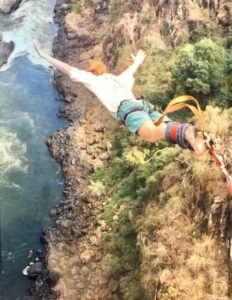
When I was a young, cocky 18-year-old I bungee jumped from what was then the highest bungee jump in the world, the Victoria Falls bridge between Zimbabwe and Zambia. Not only is the location stunning but at 111 metres high over the raging waters of the Zambezi river it is an awe-inspiring spectacle.
The thing about being a young, cocky 18-year-old is that you don’t want to lose face; our actions are often driven by ego. You feel bulletproof and are willing to take on all manner of risks, so when standing on the edge of the platform, looking down to the abyss I didn’t think twice about what could go wrong.
Three,
Two,
One,
Bungee!
Off the edge, hurtling towards the river at 9.8m/second.

But that was then, and fast forward 25 years and I doubt I would have the courage to do it again. Travelling through New Zealand a few years ago and watching bungee jumpers in Queenstown the heart was willing but, no longer fuelled by ego, the mind was firmly saying no.
In reality, nothing had changed, the risks were still the same. If anything they are lower now because I would imagine the health & safety requirements have tightened up, even in remote places like the Zambezi River.
All that has changed is my perception of the risks. I feel that bungee jumping is risky so I don’t want to give it a go.
Stock Market Investing Can Feel Like Bungee Jumping
When you are young and working you might feel that investing in company shares is not at all risky. It’s not that stock markets won’t fall but the thought of them doing so is not troubling. In fact, when regularly contributing to a pension or Share ISA, stock market falls are a good thing because your monthly contributions buy shares at a sale price when markets crash. Who doesn’t love a bargain!
And in your 30s, 40s and 50s you can have many decades to benefit from the upward trend of stock market growth.
For many, though, as they approach and enter retirement the perception of the risk of the stock market, like that of bungee jumping, increases.
The risk of stock markets falling doesn’t change. There is no formula to say that when share prices relative to company earnings reach a certain point, or when it has been so many years since the last crash, or when record highs are being surpassed that stock markets will tumble. The tipping point for stock market falls are many and varied and never predictable; a global pandemic being a good example.
Now, I’m not saying that stock market investing is right for everyone with all of their money. Risks do exist and money has to be allocated according to needs, objectives, timeframes and one’s ability to withstand temporary falls in value without negatively impacting financial security.
The point is though, at 60, a retiree of normal health can expect a multi-decade retirement. A 70-year-old male can expect to live to 86 and has a 25% chance of living to 92. A 70-year-old woman can expect to live to 88 and has a 25% chance of living to 94*.
With these timeframes to play with the chances of a permanent loss from stock market investing is very low, to the point of non-existence. As this chart** shows, since the 1900s the longest bear market was less than 3 years in length and occurred during the worst economic crisis of all time, The Great Depression. Looking back at history you can expect to generate a positive return if you invest for at least five years, for many retirees that is short enough to make it worthwhile.
As with jumping off perfectly good bridges, the actions you take with your money comes down to what you are trying to achieve and understanding the risks inherent in each option.
For the cocky 18-year-old the risk of losing face amongst friends was greater than the risk of the bungee cord breaking. For the retiree, the risk of inflation eroding the purchasing power of money is greater than losing it all to the stock markets.
*Source: Office for National Statistics
** Source: EBI Portfolios Ltd.
Photo by Datingjungle on Unsplash






